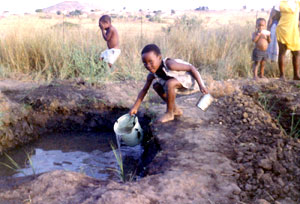A global overview
Global water consumption increased six fold in the last century - more than twice the rate of population growth - and will continue growing rapidly in coming decades. Yet readily available freshwater is a finite resource, equivalent to less than 1% of the water on Earth. If all the freshwater on the planet was divided equally, there would be 5,000 to 6,000 m³ of water available per person per year. This global calculation gives an impression of abundance. However, water and populations are unevenly distributed across the globe. Arid and semi-arid regions receive only 2% of all surface runoff yet account for 40% of the global land area and house half of the world's poor.
Water scarcity is a relative concept comparing the availability of water to actual use. The areas of most severe physical water scarcity are those where high population densities converge with low availability of freshwater. Water scarcity can also be economic, when water resources are abundant relative to water use, but insufficient infrastructure or financial capacity prevents people from accessing the water they need.
In the United States and Europe, the average individual uses between 200 and 600 l of water per day compared to the 20 l deemed to be the minimum daily requirement for drinking, washing, cooking and sanitation.
Formally speaking, when per capita water supply is less than 1,700 m³ per year, an area suffers from water stress and is subject to frequent water shortages. Today, 2.3 billion people live in such water-stressed areas. If current trends continue, water stress will affect 3.5 billion - or 48 % of the world's projected population - in 2025.

Per Capita Water Use, 2000 (m³ per year). Source: EarthTrends 2007
A look at Africa

Areas of physical or economical water scarcity.
Source: Comprehensive Assessment of water management in Agriculture
An increase in the need for fresh water by growing populations, coupled with a history of periodic drought and evidence of recent increased rainfall variability due to climate change, has created conditions of water scarcity and water stress in many regions throughout Africa. Lack of water often constrains farming and human activities, while water pollution diminishes its availability and is a source of waterborne diseases.
It is estimated that over 300 million of African people face water scarcity conditions, which formally means the per capita water supply is lower than 1,000 m³ per year. About 75% of the African population relies on groundwater as the major source of drinking water, particularly in northern and southern Africa. However, groundwater represents only about 15% of the continent's total renewable water resources.
What will the future bring?
Continued climate change will aggravate this situation. By 2050, it is expected that areas experiencing water shortages in sub- Saharan Africa will have increased by 29%. By 2100, water flow in the Nile River region is expected to decrease by 75%, with damaging consequences for irrigation practices. Declining water levels in many rivers and lakes is expected to affect water quality, exacerbate waterborne diseases, and reduce available hydropower.

Collecting water.
Source: © 2006, The Siyazisiza Trust

Countries expected to experience water stress or scarcity in 2025 - Source: UNEP 1999a
Sources
AFRICA Atlas of Our Changing Environment - UNEP
Africa Environment Outlook 2 - Chapter 4 Freshwater - UNEP
Africa Focus
Copingwith water scarcity - UN Water
The Multiple Dimensions of Water Scarcity - Earth Trends
Water: A Human Right - UNDP
2007 World Water Day - UN Water
This page was written in 2009, as additional information to the poster series "10 years of Imaging the Earth"